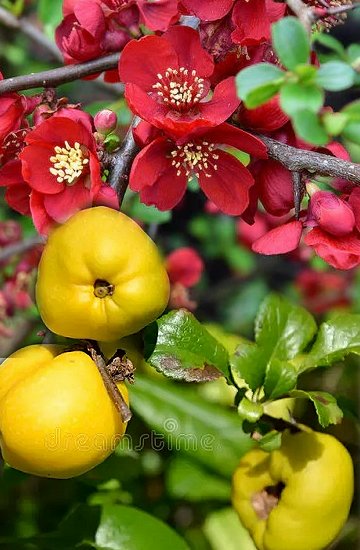
|
|
Japanese Quince
(Chaenomeles japonica). Flowers and fruits.
|
Japanese Quince - Chaenomeles japonica
Chaenomeles japonica, called the Japanese quince, Maule's quince, or "Japonica", is a species of flowering quince that is native to Japan.
The plant is harvested from the wild for use as a food and a medicine. It is sold in local markets. It is sometimes cultivated for its fruit, and is commonly grown as an ornamental, valued especially for its showy flowers in the spring.
It is a thorny deciduous shrub that is commonly cultivated. Not to be confused with Chaenomeles speciosa, which is also sometimes referred to as Japanese quince. Chaenomeles
japonica is shorter than another commonly cultivated species C. speciosa, growing to only about 1 m in height. It is best known for its colorful spring flowers, which are red, white, pink or multicoloured.
Chaenomeles japonica is native
to Southern and Central Japan and have been growing naturally since ancient times. The low-growing shrubs are traditionally found alongside lakes and riverbanks, on hillsides, and in coastal regions, generally staying in areas between 100 to 2100 meters in elevation. There are four main species in the Chaenomeles genus, and Chaenomeles japonica is the only species to have originated in Japan.
Chaenomeles japonica is a bulky deciduous shrub with thorns and widely spreading branches, which reaches heights of growth of 0.6 to 2.0
meters at a medium rate.
It is hardy and is not frost tender. The species is hermaphrodite (has both male and female organs) and is pollinated by Bees.
The leaves are lanceolate to obovate, roughly toothed and glabrous even when young. They are 4 to 5 inches long and 2 to 3 inches wide, including the petiole. The unusually large stipules are 1 centimeter long and 1.5 to 2 centimeters wide, kidney-shaped and serrated on the edge; they are only found on long shoots.
It blooms in winter, before leaf budding; it blooms again in summer but with less abundance. Usually there are 2 to 3 flowers arranged together; they are coloured orange to brick red. When open, the flowers are 3 to 4 centimeters wide. The fruit is called Kusa-boke (草木瓜, Kusa-boke) in Japanese. It produces apple-shaped fruit, 4 to 7 centimeters in diameter, that are a golden-yellow color containing red-brown seeds.
The fruit is edible, but hard and astringent, unless bletted or cooked. The fruits are not edible raw, but as with all fruits of the rose
family (Rosaceae), the pulp is non-toxic and the kernels contain small amounts of poison.
The fruit is occasionally used imparting a strong pleasant flavour to jams and jellies, it is especially good cooked with apples in apple
pies, as a substitute for its cousin, the true quince, Cydonia oblonga.
Japanese quinces are popularly infused into shochu in
Japan to make a liqueur known as karinshu. This seasonal beverage is customarily enjoyed during the winter season,
Mugua is a Chinese traditional medicine derived from the fruits of Chaenomeles species. Whilst Chaenomeles speciosa is the species most commonly mentioned in the literature for its medicinal properties, in practice the fruits of all species in the genus are used interchangeably. Modern research has supported this and, indeed, shown that some of the other species actually have higher antioxidant value.
The fruit is analgesic, anti-inflammatory, antimicrobial, antioxidant, antispasmodic, astringent, digestive and hypoglycaemic. A decoction is used internally in the treatment of a wide range of conditions, including nausea, joint pains, rheumatoid arthritis, hepatitis, asthma, common cold, cholera and associated cramps.
The fruit contains polyphenols, flavonoids, triterpenes and proanthocyanidins which have been shown to have a strong antioxidant activity. Antioxidant compounds such as these have been shown to protect against
cardiovascular diseases and also exhibit anti-tumour, antimicrobial, anti-adhesive, and anti-inflammatory effects.
C. japonica is also popularly grown in bonsai. It accepts all types of soil, but grows very slowly in calcareous soil.
Source:
https://en.wikipedia.org/wiki/Chaenomeles_japonica
https://temperate.theferns.info/plant/Chaenomeles+japonica
https://specialtyproduce.com/produce/Wild_Japanese_Quince_22102.php
